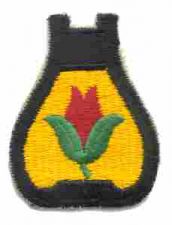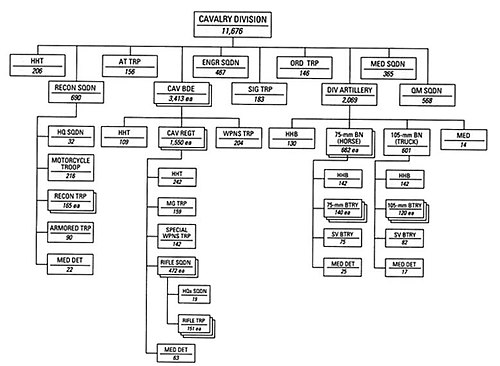
The 35th Infantry Division, formerly known as the 35th Division, is an infantry formation of the United States Army National Guard headquartered at Fort Leavenworth, Kansas.

The 6th Infantry Division was an infantry division of the United States Army active in World War I, World War II, and the last years of the Cold War. Known as "Red Star", it was previously called the "Sight Seein' Sixth".

The 34th Infantry Division is an infantry division of the United States Army, part of the National Guard, that participated in World War I, World War II and multiple current conflicts. It was the first American division deployed to Europe in World War II, where it fought with great distinction in the Italian Campaign.

The 33rd Infantry Division was a formation of the U.S. Army National Guard between 1917 and 1968. Originally formed for service during World War I, the division fought along the Western Front during the Battle of Amiens, the Battle of Hamel, the Meuse-Argonne Offensive, at the Second Battle of the Somme, and at the Battle of Saint-Mihiel. It was re-formed during the inter-war period, and then later activated for service during World War II, seeing action against the Imperial Japanese Army in the Pacific. In the post war era, the division was reconstituted as an all-Illinois National Guard division. In the late 1960s, the division was reduced to a brigade-sized formation, and its lineage is currently perpetuated by the 33rd Infantry Brigade Combat Team.

The 27th Infantry Division was a unit of the Army National Guard in World War I and World War II. The division traces its history from the New York Division, formed originally in 1908. The 6th Division designation was changed to the 27th Division in July 1917.

The 28th Infantry Division ("Keystone") is a unit of the Army National Guard and is the oldest division-sized unit in the Department of Defense. Some of the units of the division can trace their lineage to Benjamin Franklin's battalion, The Pennsylvania Associators (1747–1777). The division was officially established in 1879 and was later redesignated as the 28th Division in 1917, after the entry of America into the First World War. It is today part of the Pennsylvania Army National Guard, Maryland Army National Guard, Ohio Army National Guard, and New Jersey Army National Guard.
The 113th Cavalry Regiment is a cavalry regiment of the Iowa National Guard, with history tracing back to the 19th century Indian Wars.

The Pennsylvania Army National Guard, abbreviated PAARNG, is part of the United States Army National Guard and is based in the U.S. Commonwealth of Pennsylvania. Together with the Pennsylvania Air National Guard, it is directed by the Pennsylvania Department of Military and Veterans Affairs. The PAARNG maintains 124 armories and is present in 87 communities across the Commonwealth.

The Georgia Army National Guard is the Army National Guard component of the Georgia National Guard, administratively part of the Georgia Department of Defense. It consists of more than 11,100 citizen-soldiers training in more than 79 hometown armories and regional facilities across the state. Georgia’s Army Guard is the sixth largest in the nation and includes combat, combat support and combat service support units.

The 21st Cavalry Division was a United States Army division with units located primarily in the northeastern United States. The division was created from the perceived need for additional cavalry units after the First World War. It numbered in succession of the Regular Army divisions, which were not all active at its creation.
The 23rd Cavalry Division was a cavalry formation of the United States Army National Guard during the interwar period.

The 24th Cavalry Division was a cavalry division of the United States Army, mostly drawn from the National Guards of the Midwest states. It was created after World War I from the perceived need for additional cavalry units. It numbered in succession of the Regular Army divisions, which were not all active at its creation. Going into World War II, the US Army Cavalry Branch contained three Regular Army, four National Guard, and six Organized Reserve cavalry divisions, as well as one independent cavalry brigade.

The 62nd Cavalry Division was an Organized Reserve cavalry unit of the United States Army.
The 64th Cavalry Division of the United States Army Organized Reserve was created from the perceived need for additional cavalry units. It numbered in succession of the Regular Army Divisions, which were not all active at its creation. The 64th Cavalry Division was dispersed across the United States. The division was composed of personnel from Kentucky, Massachusetts, Vermont, New Hampshire and West Virginia.

The 108th Cavalry Regiment is a cavalry regiment of the Georgia and Louisiana Army National Guards of the United States Army.

The 116th Cavalry Brigade Combat Team is the largest formation of the Idaho Army National Guard. It is headquartered at Gowen Field, Boise, Idaho. It has been reorganized into an Armored Brigade Combat Team (ABCT) but remains the only unit to be designated a "Cavalry Brigade Combat Team" by special appointment of the US Army. The 116th Cavalry Brigade Combat Team has units located throughout Idaho, Montana, Oregon, and Nevada. It was reorganized into a heavy armor brigade in 1989. Often referred to as the Snake River Brigade and formerly known as the 116th Armored Cavalry Regiment, the unit includes about 3,000 citizen-soldiers from Idaho.

The 107th Cavalry Regiment, Ohio Army National Guard, is a parent regiment under the U.S. Army Regimental System, with headquarters at Hamilton, Ohio. It currently consists of the 2nd Squadron, 107th Cavalry Regiment, part of the 37th Infantry Brigade Combat Team (BUCKEYE), Ohio National Guard located throughout southwest Ohio.
The 110th Cavalry Regiment was a regiment in the United States Army National Guard and was part of the Massachusetts Army National Guard.

The 104th Cavalry Regiment is a Regiment of the United States Army first established in 1921. Troop A, 1st Squadron is one of several National Guard units with colonial roots and campaign credit for the War of 1812.

The 2nd Squadron, 107th Cavalry Regiment is a cavalry squadron of the 37th Infantry Brigade Combat Team and the Ohio National Guard located throughout southwest Ohio.
















